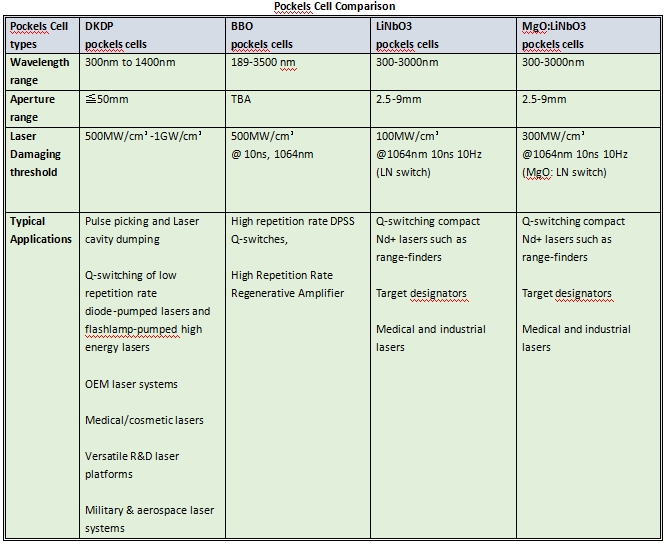Modules or Types:
|
Aperture |
2.5mm |
5mm |
8mm |
9mm |
| Shell Size |
φ20 x 66mm |
φ25.4 x 36mm |
φ30/32 x 26/30mm |
φ31/32 x 26mm |
| λ/4 Voltage |
400V λ/2 @
633nm |
800V λ/2 @
633nm |
1800V-1900V λ/4 @1064nm |
2100V λ/4 @
1064nm |
| Overall Transmittance |
>98% |
>98% |
>98% |
>98% |
| Insertion Loss |
3% |
3% |
3% |
3% |
| Output Tuning
Q Energy |
100mJ |
100mJ |
100mJ |
100mJ |
| Crystal Through
Distortion |
λ/4 @ 633nm |
λ/4 @ 633nm |
λ/4 @ 633nm |
λ/4 @ 633nm |
| Flatness |
λ/8 @ 633nm |
λ/8 @ 633nm |
λ/8 @ 633nm |
λ/8 @ 633nm |
| Extinction Ratio |
200:1 at 5mm
section |
200:1 at 5mm
section |
200:1 at 5mm
section |
200:1 at 5mm
section |
| Capacitance |
5pF |
5pF |
5pF |
5pF |
| Damage Threshold |
100MW/cm2 1064nm 10ns 10Hz (LN switch)
300MW/cm2 1064nm 10ns 10Hz (MgO: LN switch) |
Specifications:
|
Aperture |
Min. 5x5mm Max. 20x20mm |
Length |
~60mm |
| Orientation |
12 arc min |
Flatness |
λ/8 @ 633nm |
| Wavefront Distortion |
λ/4 @ 633nm |
Parallelism |
< 20 arc sec |
| Perpendicularity |
< 5 arc sec |
Surface Quality |
10/5 after coating 20/10 |
| Wavelength |
300-3000nm |
|
LiNbO3 and MgO: LiNbo3 crystals are a kind of photoelectric material that has been integrated into a wide range of applications on account of their excellent electro-optical characteristics, low cost, and excellent mechanical, thermal, and chemical properties. The electro-optic characteristic of LiNbO3 crystals is utilized for electro-optical modulations. Lithium Niobate crystals have become one of the most popular electro-optical materials for Q-switches and phase modulators attributed to their large electro-optic coefficients, non-deliquescence, good transmission up to 4.0 µm, and low half wave voltage. Operating in the transverse mode, LiNBO3 Pockels cells can be configured to run at a lower voltage than KD*P Pockels cells. LiNbO3 Pockels cells could support operations in infrared wavelengths up to 4.0 µm, and are also great choices for applications in low and medium-power solid-state lasers ( Er:YAG, Ho:YAG, Tm:YAG pulsed lasers). Damage threshold could be problematic for lithium-niobate at short wavelengths because of color center formation. Above 800nm, however, the problem attenuates and the material then has a decent damage threshold. On the other hand, LiNbO3 with MgO doping has a much higher damage threshold than conventional LiNbO3 without doping.
Hangzhou Shalom EO offers
pockels cells made from LiNbO3 crystals and MgO:LiNbO3 crystals, with aperture size of 2.5mm to 9mm. The
LiNbO3 and MgO:LiNbO3 crystals with Cr-Au electrode for electro-optical modulators or pockels cells are also offered.
To check the stock list of LiNbO3 and MgO:LiNbO3 Pockels Cells, please click here.
Features:
- Wide range of optical transmission (420 nm to 5200 nm)
- Large electro-optical coefficients and low loss
- Stable mechanical and chemical properties
- High-temperature endurance and low wavefront distortion
Applications:
- Q-switching compact Nd+ lasers such as range-finders
- Target designators
- Medical and industrial lasers
When it comes to practical applications of Pockels cells, one might need to take some additional side effects into account:
- Etalon effects might still exist and affect the optical performance if the beam direction is perpendicular to the faces of the crystal, Even when the end faces of the crystal are coated with high-quality AR coatings.
- The temperature could significantly affect the obtained phase changes. For example, a Pockels cell set to generate perfect high-contrast amplitude modulation might require readjustments of the operation voltages when the temperature changes. However, there are thermally compensated double-crystal designs that might circumvent the problem.
- For an operation with a large beam radius, it is worth paying attention to sort out an optimized design for electrodes (possibly with additional auxiliary electrodes for high uniformity of the generated electric field, as otherwise one may obtain a spatially varying modulation).
- Nonlinear crystals often exhibit substantial piezo-electric and electrooptic effects, which can have substantial influences on the performance at high modulation frequencies.
- Operating at high power levels, thermal effects may be induced by residual absorption of the crystal. Therefore materials with lower absorption are preferable for high-power applications
- The crystals used in Pockels cells are nonlinear crystal materials, they inherently demonstrates considerable optical nonlinearities. For instance, self-phase modulation and nonlinear self-focusing might occur for light pulses with substantial peak power.
Pockels Cell Comparison Chart:

LiNbO3 Crystals
- Wide transmission wavelength range of 350-5200nm
- high damage threshold and great mechanical strength
- Ideal for manufacturing isolators, circulators, beam displacers, and polarizing optics
- Two precision grade options: standard/high-precision
- Crystal ingots, blanks, and polished substrates available
...
